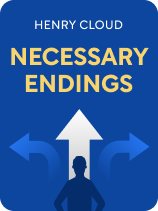

This article is an excerpt from the Shortform book guide to "Necessary Endings" by Henry Cloud. Shortform has the world's best summaries and analyses of books you should be reading.
Like this article? Sign up for a free trial here.
Why should you evaluate your relationships? What are things to look out for as red flags in relationships?
Some relationships just aren’t meant to last forever. If you feel as though a relationship is taking a negative toll on your life, you need to take a step back and assess how important it is to you.
Here are the factors you need to evaluate in your relationships, according to Necessary Endings by Henry Cloud.
Assess Difficult Relationships
Cloud offers a set of strategies for evaluating your relationships that may need to end. He recommends that you consider the structural factors around the relationship, use character as a basis for assessment, and put the ball in the other person’s court.
(Shortform note: In addition to the tools Cloud offers for assessing your relationships, experts recommend getting outside perspectives on relationships. Specifically, if your friends and family have a negative view of one of your relationships, it may be a sign that the relationship needs to end. While you may be too close to the relationship to accurately assess it, your loved ones may have the outside perspective necessary to make a more objective judgment.)
Consider Structural Factors When Assessing Relationships
When you have an issue with someone’s behavior, you should consider the structural factors that influence that behavior—this is especially relevant in the context of employees. You should first assess whether the person is in the right position. Even the most talented employees will struggle in ill-fitting roles. Then, determine whether the person has the institutional support they need to succeed. When employees fail, it may often be due to issues beyond their control, such as a lack of resources or coaching in their work environment.
| Have Your Employees Been Set Up to Fail? As you assess the structural context of an employee’s performance, consider whether they’ve been set up to fail. Management writers note that in trying to help employees who are perceived to be struggling, managers often do more harm than good. By increasing oversight of these employees, managers begin a vicious cycle in which increased supervision lowers employee confidence and performance, which leads management to continue to increase supervision. Over time, this leads to strained relationships between management and employees and lost productivity. To assess whether your employees are being set up to fail, consider the quality of their relationships with management. If these relationships became strained at the same time as performance dropped, it may be a sign that your employees have been set up to fail. |
Use Character to Assess Relationships
Once you’ve considered the structural factors at play, assess relationships based on your impression of the other person’s character. Cloud claims that character is predictive of whether or not people will be receptive to change and feedback.
According to Cloud, people can generally be sorted into three categories based on their character. There are responsible people, irresponsible people, and dangerous people. Cloud offers different strategies for dealing with each type of person. (Cloud notes that people are too complicated to truly fall into three simple categories; however, these three categories can still be a useful heuristic for determining which relationships to end.)
1) Responsible people (Cloud refers to them as “wise people”): Responsible people are characterized by their ability to take ownership of their actions. They’re able to admit and apologize when their mistakes have hurt others, and they readily incorporate feedback and change unwanted behaviors.
2) Irresponsible people (Cloud refers to them as “fools”): As you might expect, irresponsible people are in many ways the polar opposites of responsible people. Irresponsible people are unable to take responsibility for their actions, instead finding an external factor to blame for any mistakes they make. When pressed about their behaviors, they’ll deflect or become heated and defensive.
When dealing with irresponsible people, it doesn’t always help to communicate directly about problem behaviors. Instead of critiquing specific misbehaviors, Cloud recommends calling out their overall inability to accept responsibility for their action. Point out to irresponsible people that they always find someone or something else to blame when things go wrong—this can sometimes help them change their patterns. Setting consequences also works well with irresponsible people, as it forces them to bear the weight of their own mistakes, which encourages them to change their behavior.
3) Dangerous people (Cloud refers to them as “evil people”): Dangerous people are completely unlike the first two groups. Whereas both responsible and irresponsible people may sometimes cause harm by accident, dangerous people intend to harm others with their words and their actions. They are unsafe to be around.
None of the strategies we have listed are effective in dealing with dangerous people. According to Cloud, nothing you can do will change their behavior. Instead, end any and all relationships with dangerous people, and do your best to keep away from them. Cloud notes that deterrents, such as legal actions or calls to law enforcement, can be effective in keeping dangerous people away.
Let the Other Person Decide
If, after assessing someone’s character, you’re still not certain whether to end your relationship with them, it can help to let the other person decide (Cloud refers to this process as “self-selection”). Letting the other person decide entails communicating your standards to the other person and allowing them to choose whether they want to live up to those standards.
(Shortform note: Communicate your expectations clearly when you allow the other person to decide. Leadership experts note that people can’t live up to your standards if you don’t clearly communicate them in the first place. In workplace settings, it can be helpful to create a list of “always” and “never” behaviors for employees—for example, communication procedures that must always be followed or interpersonal behaviors that are never acceptable. Creating such clear-cut criteria makes it easier for employees to decide if they want to work with you.)
Cloud points out that allowing the other person to make the decision has benefits for both parties. If you struggle with guilt when imposing consequences in relationships, allowing the other person to make the decision can help alleviate this feeling. This style of decision-making can feel more inclusive to the other person—instead of passing down behavioral mandates, you’re including them in the decision-making process.
For example, suppose you have an employee who does excellent work but is lax about deadlines. You could simply tell them to work harder, or you could let them decide. Let them know that you admire their work and want them to succeed, but in order to stay with the company, they’ll need to meet their next set of deadlines. This clarifies your expectations for the employee and puts the power in their hands. At the same time, it gives you a clear-cut, guilt-free way to decide whether to end the relationship.(Shortform note: Experts argue that when employees are involved in decision-making processes, they tend to feel more engaged and perform better. Based on these findings, including employees in a mutual decision-making process about their role may help encourage them to rise to your standards.)

———End of Preview———
Like what you just read? Read the rest of the world's best book summary and analysis of Henry Cloud's "Necessary Endings" at Shortform.
Here's what you'll find in our full Necessary Endings summary:
- That pulling out of a bad situation is the best way to move forward in life
- How to assess which situations and relationships need to end
- How to make sure that your endings stick






